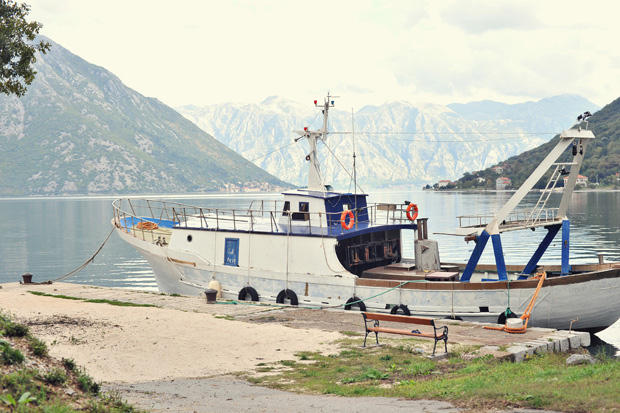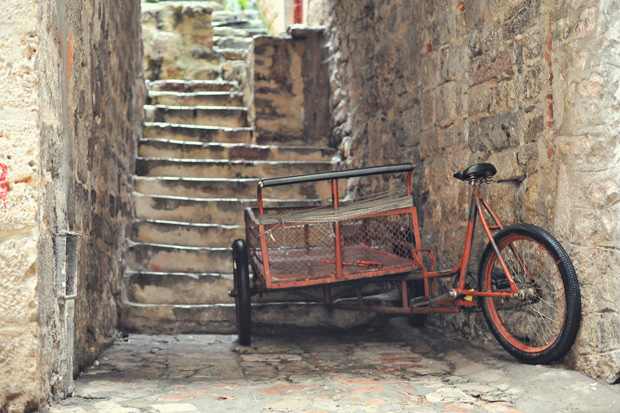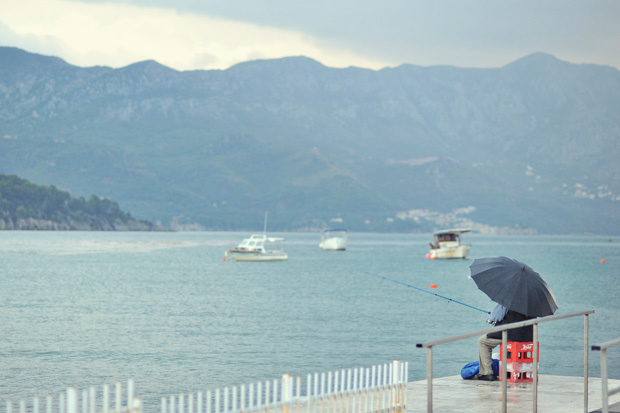Again, we stopped at scenic views that didn't allow us to simply drive by. Our eyes marveled at the water, mountains, and sky running into each other. We followed the sound of crashing water to catch sights of waterfalls and stopped to say hello to goats grazing on the hillside of the road. We noticed the language is very similar to Croatian, but when reading signs, some were written in Cyrillic (which made the language even more similar to Russian) and some in Latin characters (the majority). Every small town we passed had a characteristic church steeple in the center, which looked identical to the last.
Our first stop was the tiny town of Perast which sits on the edge of the bay. I have never experienced a more peaceful town. The charming venetian buildings of Perast are built right along the water, which no room for a beach. The town is all about the sea. Out on the water in front of Perast are two tiny islands, each holding a church, and only a church. With the light hitting the churches just right, they looked like gems on the sea. One of those islands, Gospa od Škrpjela ("Our Lady of the Rock"), is the only man-made island on the Adriatic, and was built upon a rock after two sailors from Perast found a picture of the virgin Mary on it in 1452. We decided to have lunch at one of the only restaurants on the main street of Perast. Our table sat on the edge of the water. Majestic mountains surround the water on all sides, protecting the beautiful bay and the city. As we ate, dark clouds quickly moved overhead, turning the mountains mean and casting shadows over the water. The contrasting shades of light and dark and the motion of clouds and water created so much drama that is impossible to describe with words. We had the most delicious creamy seafood soup before our entrees. As we finished our lunch, a light sprinkle of rain began, which we noticed first by the visible drops on the sea--the most perfect timing. We got up to continue our drive.
Next, we pulled over and explored Kotor on foot. It is a small city located on beautiful Kotor Bay, which is known as the "bride of Adriatic" because of its beauty. The ancient walled city of Kotor was built between the 14th and 16th century, and has medieval buildings, churches, and cultural landmarks typical of the middle Ages. Turquoise water sits still again the stony wall at the entrance. The structures of the city begin to climb up the mountains behind it. As I drew my eyes up the side of the mountains, I could make out a stony wall that zig-zagged up the steep rocky terrain and was broken up by taller watchtowers. From afar, the wall is not visible as it camouflages right into the rocky mountains (look for it closely in our photos). The wall reaches 850 feet at the highest point and can be walked by foot. The city is another UNESCO's World Heritage Site-- the third we had seen in a matter of days (the other two being Diocletian's Palace in Split and the Old City of Dubrovnik)!
Our final destination was the city of Budva, the center of Montenegro's tourism. By the time we got there, our sunny weather had entirely dissipated and we drove through the city in a rain downpour. We felt compelled to walk to the water at one beach just because we had driven the distance, and ran back to the car for shelter. The city had some flashy hotels, restaurants, and casinos lit by neon lights, and we could tell why it was a vacation town. Not surprisingly, Budva also has an "old town" which dates back to the 5th century BC. We had no interest to explore it after all the old towns we'd walked and driven through. Anywhere we go, the land is steeped in so much history, it almost becomes difficult to appreciate it.
The day trip was definitely worth the drive, and we added one more country to our list of "places we've been". Montenegro gave us our most beautiful and memorable lunch yet.
-Julia
Perast, Montenegro
Kotor, Montenegro
Budva, Montenegro



































































